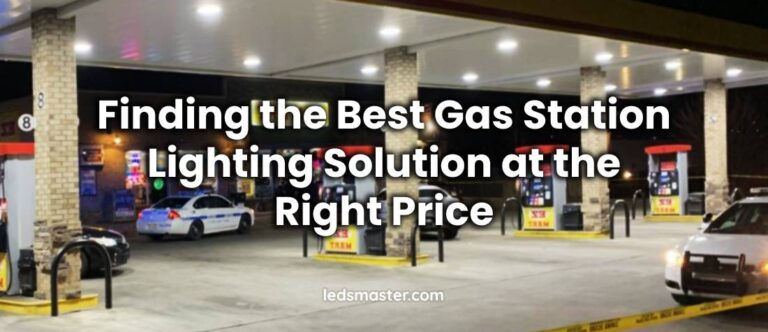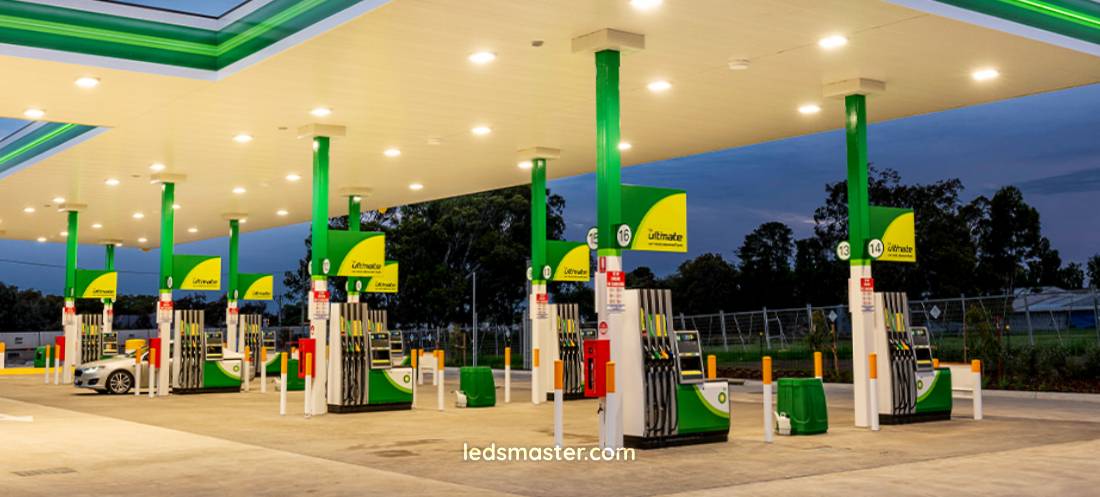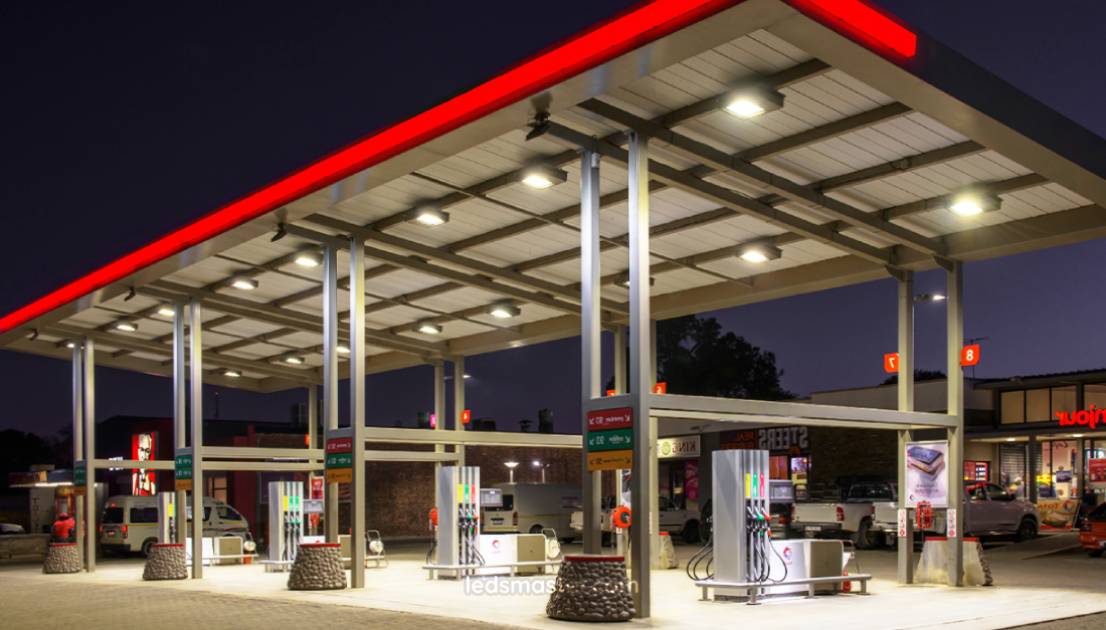
Whether it’s guiding drivers to the fuel pumps in the middle of the night or ensuring visibility for security purposes, effective lighting is a cornerstone of any well-functioning gas station. From the initial installation expenses to the ongoing energy consumption and maintenance, understanding the full scope of gas station lighting costs is essential for making informed decisions.
Get your complimentary lighting design today
Lighting in a gas station serves both functional and safety purposes, ensuring visibility for customers and employees at all hours of operation. However, the cost associated with the lighting of a gas station can vary widely depending on the type of lighting system, location, and operational considerations. There are several factors to consider when determining the total cost of lighting at a gas station, including initial installation, ongoing operational expenses, strategies for reducing energy consumption, and the need to comply with lighting regulations and standards.
Table of Contents
ToggleThe initial cost of setting up the lighting system in a gas station involves several factors. The choice of lighting technology, such as LED or traditional incandescent bulbs, will greatly impact both the upfront investment and the long-term energy savings. The lighting system must be chosen to ensure the gas station meets local safety and visibility requirements. Moreover, installation costs depend on the scale of the lighting infrastructure and the complexity of the setup.
| Cost Category | Cost Range | Description |
|---|---|---|
| Installation Costs | $5,000 to $70,000 | Includes lighting system setup, electrical infrastructure (wiring, panels, circuit breakers), and specialized lighting for fuel pumps. Larger stations may require additional fixtures or higher wattage, driving up costs. Regulatory compliance checks may add $1,000 to $5,000. |
| Electricity Consumption (LED) | $7,000 to $21,000 annually | Switching to LED lighting can reduce energy consumption by up to 70%, saving substantial amounts annually compared to traditional lighting systems. For a 24-hour station, electricity costs for lighting can range from $10,000 to $30,000 per year. |
| Electricity Consumption (Traditional) | $10,000 to $30,000 annually | Traditional lighting systems (incandescent or fluorescent) are less energy-efficient, leading to higher ongoing electricity costs compared to LED systems. |
| Lighting Control Systems (Motion Sensors, Timers) | $1,000 to $6,000 annually | Installing systems like motion sensors or automated dimming can reduce electricity costs by 10-20%, with annual savings ranging from $1,000 to $6,000. |
| Maintenance & Replacement (Traditional) | $2,000 to $5,000 annually | Includes costs for replacing bulbs, repairing wiring, and maintaining fixtures. Traditional systems require more frequent upkeep compared to LEDs. |
| Maintenance & Replacement (LED) | $2,000 to $5,000 annually | LED systems have a longer lifespan and require less frequent maintenance, but occasional repairs and part replacements are still necessary. |
| Labor Costs for Maintenance | $50 to $150 per hour | Labor costs for technicians to replace bulbs, repair components, or conduct regular system inspections. The total cost depends on the frequency of repairs and the complexity of the lighting system. |
| Unscheduled Maintenance | $3,000 to $10,000 annually | Unplanned repairs due to system malfunctions or electrical issues can increase overall maintenance costs, especially for larger or more complex systems. |

The type of lighting technology chosen is one of the primary elements influencing the implementation cost. LED lighting has gained popularity in recent years due to its lower energy consumption, longer lifespan, and reduced maintenance costs compared to older lighting options such as fluorescent or incandescent bulbs. However, LED fixtures often come with a higher initial cost. Gas stations must balance the upfront investment with potential savings in energy and maintenance costs over time.
For example, while LED lights may cost more at the outset, their efficiency in energy usage and longer life expectancy can result in lower operational costs over the years. On the other hand, traditional lighting options may have lower upfront costs but higher energy consumption and frequent bulb replacements. The installation process itself also adds to the overall implementation cost, as qualified electricians are needed to install the lighting fixtures correctly, taking into account local regulations and safety standards.
The installation of the lighting system in a gas station requires attention to detail to ensure that the lighting is positioned properly for maximum visibility and safety. The cost of the electrical infrastructure, including wiring, panels, and circuit breakers, must be taken into account. Additionally, gas stations often need specialized lighting to ensure that the fuel pumps and surrounding areas are adequately illuminated for safe customer use.
Installation costs can vary widely depending on the size of the gas station, the complexity of the electrical layout, and the need for any additional equipment. On average, the cost for setting up a basic lighting system in a small gas station might range from $5,000 to $15,000, which would cover the installation of standard fixtures, wiring, and electrical panels. For larger stations, particularly those with more extensive outdoor areas, the cost could range from $20,000 to $50,000 or more. Larger gas stations may require additional fixtures or higher wattage to ensure that the entire premises are adequately illuminated, driving up the total cost of installation. Furthermore, specialized lighting setups, such as those for high-traffic areas or safety-critical zones like fuel pumps, can increase the price by an additional $10,000 to $30,000, depending on the requirements.
The installation process also includes compliance with local regulations, which may involve inspections and certifications to ensure the lighting setup meets safety and environmental standards. These regulatory requirements can add an extra $1,000 to $5,000 to the overall cost. Overall, the total cost of installation can range from $10,000 to $70,000, with larger or more complex stations on the higher end of the spectrum.

After the lighting system is implemented, gas stations face ongoing operational costs related to electricity consumption, maintenance, and eventual replacement of lighting components. These costs can accumulate significantly over time, making it crucial to manage energy usage efficiently and ensure that the lighting system is optimized to reduce unnecessary expenses.
Electricity consumption is one of the major operational costs associated with gas station lighting. The type of lighting system installed has a direct impact on the amount of energy consumed. Traditional lighting systems, such as incandescent or fluorescent bulbs, are more energy-intensive and cost more to operate compared to modern LED lighting systems. Although LED lighting systems come with higher initial installation costs, they offer substantial long-term savings in energy usage and maintenance.
LED lights are significantly more energy-efficient than older technologies, consuming about 50-75% less energy to produce the same amount of light as traditional bulbs. The operational savings from switching to LED lighting can range from $1,000 to $10,000 annually, depending on the size of the gas station and the amount of lighting required. For a typical 24-hour gas station, electricity bills for lighting can amount to anywhere from $10,000 to $30,000 per year. By transitioning to LED lights, these costs can be reduced by up to 70%, which can result in annual savings of $7,000 to $21,000, depending on the station’s size.
The ongoing electricity costs for gas stations can be further reduced by optimizing energy use through advanced lighting control systems, such as motion sensors, timers, and automated dimming systems. These systems allow lights to be dimmed or turned off in low-traffic areas or during off-peak hours, significantly cutting down on unnecessary energy consumption. For example, the installation of motion sensors might reduce lighting energy costs by 10-20%, saving between $1,000 and $6,000 annually.
Maintenance is another recurring cost associated with gas station lighting. Lighting systems require regular upkeep to ensure they remain fully operational and safe for customers and staff. While LED lights generally have longer lifespans (around 50,000 to 100,000 hours) and require less frequent maintenance, older lighting systems may need more frequent repairs and replacements. Gas stations must budget for the costs of replacing bulbs, repairing wiring, and replacing other components such as ballasts and fixtures.
For gas stations using traditional lighting systems, the replacement of burnt-out bulbs and damaged fixtures can be frequent, resulting in ongoing operational costs. For example, the cost of replacing a traditional bulb might range from $5 to $20, but labor costs for technicians to replace and install these components can add an additional $50 to $150 per visit. Over time, these costs can add up, especially for stations that rely on older technologies.
LED lighting, on the other hand, requires fewer replacements due to its longer lifespan. However, even with LED systems, the need for occasional repairs and part replacements still contributes to maintenance costs. Labor costs for the periodic inspection and maintenance of lighting systems are also a consideration. Typically, maintenance visits can cost between $100 and $300 per service call, depending on the complexity of the system and the location of the gas station.
The cost of maintaining a lighting system in a gas station can range from $2,000 to $5,000 annually, depending on the type of lighting used, the size of the facility, and the frequency of maintenance required. For stations that rely on older lighting systems, these costs can be considerably higher.
Beyond the direct costs of materials and parts, labor costs are an integral part of the overall maintenance expenses for gas station lighting. Gas stations must either hire in-house staff or contract external electricians and technicians to ensure that the lighting systems are functioning properly. Labor costs for these services can range from $50 to $150 per hour, with a typical service call taking several hours to complete.
In large gas stations or those with multiple locations, these costs can quickly add up, especially if the lighting system requires frequent repairs or adjustments. Regular maintenance schedules help reduce the need for emergency repairs, but the labor costs still need to be accounted for in the station’s budget.
Gas stations may also need to plan for unscheduled repairs, which could be caused by system malfunctions or unforeseen issues with the electrical infrastructure. These unplanned maintenance visits can significantly increase operational costs, particularly if specialized technicians are needed to diagnose and resolve more complex issues.
Overall, the cost of maintaining a gas station lighting system, including labor, can range from $3,000 to $10,000 annually, depending on the scale of operations and the complexity of the lighting system in place.
To optimize energy usage and reduce costs, some gas stations install advanced lighting control systems. These systems can include timers, motion sensors, and automated dimming to adjust lighting according to the time of day, customer traffic, or other environmental factors. While these systems may come with installation costs, they can significantly reduce energy consumption by ensuring that lighting is only active when needed.
Advanced control systems are often integrated with the overall energy management strategy of the gas station, allowing operators to track and adjust energy use in real time. As a result, these systems can lead to long-term savings on electricity bills and improve the overall sustainability of the gas station’s operations.
In addition to optimizing energy use through efficient lighting technologies and control systems, there are other strategies that gas stations can implement to lower their lighting costs.
Regular monitoring of electricity usage is one of the most effective ways to identify areas where lighting costs can be reduced. Gas stations can analyze their energy consumption patterns and determine whether adjustments are needed. For instance, if certain areas of the station, such as parking lots or perimeter lights, are over-illuminated during off-peak hours, dimming the lights or turning them off altogether can save significant amounts of energy.
Implementing an energy management system that allows for real-time monitoring can also help gas stations spot inefficiencies quickly and take corrective action. These systems often include software that provides detailed insights into energy usage, allowing operators to make informed decisions about lighting schedules and equipment upgrades.
One of the most straightforward ways to save on lighting costs is to upgrade to more energy-efficient lighting. The transition from incandescent or fluorescent lighting to LED fixtures can result in a substantial reduction in energy consumption. LED lights not only use less energy but also last longer, reducing the need for frequent replacements and maintenance.
In addition to the initial savings, energy-efficient lighting upgrades may also qualify gas stations for rebates or incentives from utility companies or government programs aimed at promoting sustainability. These financial incentives can offset some of the initial investment costs and make the upgrade even more economical.
Another strategy for reducing lighting costs is to optimize the layout and positioning of the lighting fixtures. Ensuring that light is directed where it is most needed, such as over the fuel pumps, parking areas, and walkways, can reduce the overall number of lights required. Using strategically placed lighting can provide adequate illumination without wasting energy on areas that do not need as much lighting.
In addition, using lighting fixtures with higher lumen output and wider beam angles can help ensure that fewer lights are required to achieve the desired brightness. An optimized layout not only saves energy but also enhances the visual appeal of the gas station, providing customers with a safer and more pleasant experience.

Upgrading the lighting system at a gas station may require substantial investment. Fortunately, there are various funding options available to help cover the costs of lighting projects. These options include government incentives, utility rebates, and loans designed to support energy efficiency improvements.
In many regions, government programs and utilities offer incentives and rebates to encourage businesses to switch to energy-efficient lighting systems. These programs are designed to offset some of the initial costs of upgrading to energy-efficient technologies like LEDs. Gas stations can research and apply for these programs to help reduce the financial burden of their lighting upgrade.
Incentive programs can vary by location and may include grants, tax credits, or direct financial rebates. The availability and terms of these programs can change over time, so it is important to stay informed about current opportunities to save on lighting costs.
For gas stations that need additional funding to complete a lighting upgrade, energy-efficiency loans are another viable option. These loans are specifically designed to finance energy-saving projects, including lighting upgrades. With these loans, gas stations can spread the costs of the lighting system over several years while enjoying immediate savings on energy bills.
Energy-efficiency loans are often offered with favorable terms, including low-interest rates and flexible repayment options. In some cases, the savings on energy costs may even offset the loan payments, making these loans a financially viable solution for lighting upgrades.
Gas stations are required to comply with various local and national lighting standards and regulations to ensure safety and visibility. These regulations are designed to provide adequate lighting for both customers and employees, helping to prevent accidents and maintain a safe environment.
Each jurisdiction may have specific lighting codes that govern the illumination levels and types of lighting that are permissible at gas stations. These codes typically address aspects such as the minimum required lighting levels for fuel pumps, parking areas, and walkways. Gas stations must ensure that their lighting systems meet or exceed these standards to avoid potential fines or liability issues.
In addition to safety standards, gas stations may also need to comply with environmental regulations related to lighting. This can include limits on light pollution, particularly in areas with residential neighborhoods or natural reserves. To minimize light spillover, gas stations may be required to install shields or use specific lighting types that focus the light downward rather than allowing it to scatter into the surrounding environment.
Gas stations must take care to stay up-to-date with any changes in local regulations and ensure that their lighting systems are fully compliant.
Gas station lighting plays a key role in safety, visibility, and customer experience. However, managing the costs associated with lighting requires careful planning and consideration of both implementation and operational factors. By choosing energy-efficient lighting technologies, optimizing lighting layouts, and exploring funding opportunities, gas stations can reduce their lighting costs over time.
Additionally, staying informed about local lighting standards and regulations ensures compliance while maintaining a safe environment. With the right approach, gas stations can achieve effective lighting solutions that balance operational costs, sustainability, and safety.